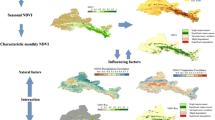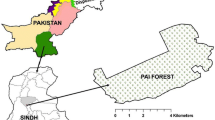Abstract
Caatinga is a typical biome of Brazil’s semiarid regions and subject to climate changes. Research is needed on the relation of its features to climate events. This study analyzed the influence of rainfall and its irregularities in open and dense woody Caatinga vegetation. Phenological curves were generated by means of Normalized Difference Vegetation Index (NDVI) time profiles in the Grota do Angico Conservation Unit study area in Sergipe State. Rainfall data from 2000 to 2018 were collected and phenological curves generated using various estimate methods that produced the following variables: [start of season, end of season, peak of season position, length of season, mean growing season and maximum seasonal]. Rainfall showed a standard intra-annual behavior, with inter-annual variations related to irregularities influencing Caatinga response. Dense Caatinga vegetation had higher values of NDVI in all periods, even in anomalous years compared to open Caatinga, in addition to having longer leaf coverage over the year, with an anticipated start and a more extended seasonal end. The analysis of the rainfall regime made it possible to assess its influence on the Caatinga and phenological profiles proved to be fundamental to understand periods of physiological change of open and dense Caatinga. These results indicate that dense Caatinga maintains physiological activity longer, which may be associated with greater moisture maintenance in a semiarid region. In addition, because it has a greater leaf cover for longer periods, the soil may be preserved and maintain its characteristics longer, reducing the effects of desertification. The results may be associated with the type of forest management and conservation in this region. The total or partial suppression of individual remnants of Caatinga should be avoided, since the most open areas have lower photosynthetic capacity, affected to a considerable extent from the effects of adverse climatic conditions. Additionally, open Caatinga has a reduced capacity for regenerating naturally and its use by communities in this semiarid region should be limited.




Similar content being viewed by others
References
Abade NA, Carvalho Júnior OA, Guimarães RF, Oliveira SN (2015) Comparative analysis of MODIS time-series classification using support vector machines and methods based upon distance and similarity measures in the Brazilian Cerrado–Caatinga boundary. Remote Sens 7(9):12160–12191
Adami M, Bernardes S, Egidio A, Freitas RM, Shimabukuro YE, Espírito-Santo FDB, Rudorff BFT, Anderson LO (2018) Seasonality of vegetation types of South America depicted by moderate resolution imaging spectroradiometer (MODIS) time series. Int J Appl Earth Obs 69:148–163
Adole T, Dash J, Atkinson PM (2018) Characterising the land surface phenology of Africa using 500 mM ODIS EVI. Appl Geogr 90:187–199
Barbosa HA, Huete AR, Baethgen WE (2006) A 20-year study of NDVI variability over the Northeast Region of Brazil. J Arid Environ 67(2):288–307
Barbosa HA, Kumar TL (2016) Influence of rainfall variability on the vegetation dynamics over Northeastern Brazil. J Arid Environ 124:377–387
Barbosa HA, Kumar TL, Paredes F, Elliot S, Ayuga JG (2019) Assessment of Caatinga response to drought using Meteosat-SEVIRI normalized difference vegetation index (2008–2016). ISPRS Photogramm Remote Sens 148:235–252
Bombardi RJ, Carvalho LMV (2017) Práticas simples em análises climatológicas: uma revisão em análises e comparações de dados com tendências. Revista Brasileira de Meteorologia 32(3):311–320
Chakraborty A, Seshasai MVR, Reddy CS, Dadhwal VK (2018) Persistent negative changes in seasonal greenness over different forest types of India using MODIS time series NDVI data (2001–2014). Ecol Indic 85:887–903
Chaves IB, Lopes VL, Folliott PF (2008) Uma classificação morfo-estrutural para descrição e avaliação da biomassa da vegetação da caatinga. Revista Caatinga 21(2):204–213
Cole MM (1960) Cerrado, Caatinga and pantanal: the distribution and origin of the savanna vegetation of Brazil. The Geogr J 126(2):168–179
Embrapa (2018) SATVeg. Sistema de Análise Temporal da Vegetação. https://www.satveg.cnptia.embrapa.br/satveg/login.html [Accessed 10 Dec 2018]
Erasmi S, Schucknecht A, Barbosa MP, Matschullat J (2014) Vegetation greenness in Northeastern Brazil and its relation to ENSO warm events. Remote Sens 6(4):3041–3058
ESA (2019) Sentinel Online. https://sentinel.esa.int/web/sentinel/sentinel-data-access Accessed 16 Jan 2019
FAO (2012) Food and Agriculture Organization of the United Nations. Global ecological zones for FAO forest reporting:2010 Update. Forest Resources Assessment Working: Rome, p. 52
Filippa G, Cremosene E, Migliavacca M, Galvagno M, Forkel M, Wingate L, Tomelleri E, Cella UM, Richardson AD (2016) Phenopix: A R package for image-based vegetation phenology. Agr Forest Meteoro 220:141–150
Formigoni MH, Xavier AC, Lima JSS (2011) Análise temporal da vegetação na região do nordeste através de dados EVI do MODIS. Ciência Florestal 21(1):1–8
Freire JLM, Lima JTA, Cavalcanti EP (2011) Análise de Aspectos Meteorológicos sobre o Nordeste do Brasil em Anos de El Niño e La Niña. Revista Brasileira de Geografia Física 3:429–444
Guimarães SO, Costa AA, Vasconcelos Júnior FC, Silva EM, Sales DC, Araújo Júnior LM, Souza SG (2016) Projeções de Mudanças Climáticas sobre o Nordeste Brasileiro dos Modelos do CMIP5 e do CORDEX. Revista Brasileira de Meteorologia 31(3):337–365
Gurgel HC, Ferreira NJ (2003) Annual and interannual variability of NDVI in Brazil and its connections with climate. Int J Remote Sens 24:3595–3609
Hmimina G, Dufrêne E, Pontallier J-Y, Delpierre N, Aubinet M, Caquet B, Grandcourt A, Burban B, Flechard C, Granier A, Gross P, Heinesch B, Longdoz B, Moureaux C, Ourcival J-M, Rambal S, André LS, Soudani K (2013) Evaluation of the potential of MODIS satellite data to predict vegetation phenology in different biomes: an investigation using ground-based NDVI measurements. Remote Sens Environ 132:145–158
INPE (2018) Series View. https://www.dsr.inpe.br/laf/series [Accessed 10 Dec 2018]
Ivits E, Cherlet M, Tóth G, Sommer S, Mehl W, Vogt J, Micale F (2012) Combining satellite derived phenology with climate data for climate change impact assessment. Glob Planet Change 88–89:85–97
Kousky VE, Cavalcanti IFA (1984) Eventos Oscilação Sul/El Niño: característica evolução e anomalias de precipitação. Ciência e Cultura 36(11):1888–1899
Lundgren WJC, Sousa IF, Lundgren GA (2017a) Krigagem na construção de mapa pluviométrico do Estado de Sergipe. Revista Brasileira de Geografia Física 10(1):13–22
Lundgren WJC, Sousa IF, Lundgren GA (2017b) Estimativa pluviométrica através das técnicas da krigagem e cokrigagem no Estado de Sergipe. Revista Brasileira de Geografia Física 10(3):854–865
NOAA (2019) National Weather Service. Center for Weather and Climate Prediction. El Niño/Southern Oscillation (ENSO). https://origin.cpc.ncep.noaa.gov/products/analysis_monitoring/ensostuff/ONI_v5.php [Accessed 10 Jan 2019]
Nóbrega RS, Santiago GACF (2016) Tendências do controle climático oceânico sob a variabilidade temporal da precipitação no Nordeste do Brasil. Revista de Geografía Norte Grande 63:9–26
Pastor-Guzman J, Dash J, Atkinson PM (2018) Remote sensing of mangrove forest phenology and its environmental drivers. Remote Sens Environ 205:71–84
Pereira ERR, Freitas JC, Andrade ARS, Souza VG (2011) Variabilidade do número de dias chuvosos no estado de Sergipe-SE. Revista Brasileira de Tecnologia Aplicada nas Ciências Agrárias 4(1):45–65
Qin YW, Xiao XM, Dong JW, Zhou YT, Wang J, Doughty RB, Chen Y, Zou ZH, Moore B III (2017) Annual dynamics of forest areas in South America during 2007–2010 at 50m spatial resolution. Remote Sens Environ 201:73–87
Redo D, Aide TM, Clark ML (2013) Vegetation change in Brazil’s dryland ecoregions and the relationship to crop production and environmental factors: Cerrado, Caatinga, and Mato Grosso, 2001–2009. J Land Use Sci 8(2):123–153
Ribeiro AS, Mello AA (2007) Diagnóstico da biota. In: Ribeiro, A.S. (coord.). Estudos para criação do Monumento Natural Grota do Angico. Sergipe: Governo de Sergipe, Secretaria de Estado do Meio Ambiente e dos Recursos Hídricos, p 12‒20
Salimon C, Anderson L (2018) How strong is the relationship between rainfall variability and Caatinga productivity? A case study under a changing climate. Ann Brazilian Acad Sci 90(2):2121–2127
Santos CAC, Brito JIB (2007) Análise dos índices de extremos para o semi-árido do Brasil e suas relações com TSM e IVDN. Revista Brasileira de Meteorologia 22(3):303–312
Santos DM, Silva KA, Albuquerque UP, Santos JMFF, Lopes CGR, Araújo EL (2013) Can spatial variation and inter-annual variation in precipitation explain the seed density and species richness of the germinable soil seed bank in a tropical dry forest in north-eastern Brazil? Flora 208:445–452
Santos MG, Oliveira MT, Figueiredo KV, Falcão HM, Arruda ECP, Almeida-Cortez J, Sampaio EVSB, Ometto JPHB, Menezes RSC, Oliveira AFM, Pompelli MF, Antonino ACD (2014) Caatinga, the Brazilian dry tropical forest: can it tolerate climate changes? Theor Exp Plant Phys 26:83–99
Schucknecht A, Erasmi S, Niemeyer I, Matschullat J (2013) Assessing vegetation variability and trends in north-eastern Brazil using AVHRR and MODIS NDVI time series. Eur J Remote Sens 46:40–59
Schulz C, Koch R, Cierjacks A, Kleinschmit B (2017) Land change and loss of landscape diversity at the Caatinga phytogeographical domain e Analysis of pattern-process relationships with MODIS land cover products (2001–2012). J Arid Environ 136:54–74
Serviço Florestal Brasileiro (2018) Inventário Florestal Nacional. Sergipe: principais resultados. MMA: Brasília, p87.
Silva VPR, Pereira ERR, Almeida RSR (2012) Estudo da variabilidade anual e intra-anual da precipitação na região Nordeste do Brasil. Revista Brasileira de Meteorologia 27(2):163–172
Silva VPR, Pereira ERR, Azevedo PV, Souza FAZ, Souza IF (2011) Análise da pluviometria e dias chuvosos na região Nordeste do Brasil. Revista Brasileira de Engenharia Agrícola e Ambiental 15(2):131–138
Sousa IF, Aguiar Netto AO, Silva BB (2014) Balanço de radiação e energia no perímetro irrigado Califórnia-SE mediante imagens orbitais. Revista Brasileira de Geografia Física 7(6):1165–1172
Testa S, Soudani K, Boschetti L, Mondino EB (2018) MODIS-derived EVI, NDVI and WDRVI time series to estimate phenological metrics in French deciduous forests. Int J Appl Earth Obs 64:132–144
Zheng C, Tang XG, Gu Q, Wang TX, Wei J, Song LS, Ma MG (2018) Climatic anomaly and its impact on vegetation phenology, carbon sequestration and water-use efficiency at a humid temperate forest. J Hydrol 565:150–159
Acknowledgements
The authors thank the National Council for Scientific and Technological Development (CNPq) and the Coordination of Superior Level Staff Improvement-Brazil (CAPES) for supporting this research.
Author information
Authors and Affiliations
Corresponding author
Additional information
Publisher's Note
Springer Nature remains neutral with regard to jurisdictional claims in published maps and institutional affiliations.
Project funding: National Council for Scientific and Technological Development (CNPq) and the Coordination of Superior Level Staff Improvement-Brazil (CAPES).
The online version is available at http://www.springerlink.com.
Corresponding editor: Tao Xu.
Rights and permissions
About this article
Cite this article
de Jesus, J.B., Kuplich, T.M., de Carvalho Barreto, Í.D. et al. Temporal and phenological profiles of open and dense Caatinga using remote sensing: response to precipitation and its irregularities. J. For. Res. 32, 1067–1076 (2021). https://doi.org/10.1007/s11676-020-01145-3
Received:
Accepted:
Published:
Issue Date:
DOI: https://doi.org/10.1007/s11676-020-01145-3




